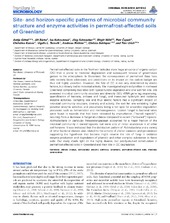| dc.contributor.author | Gittel, Antje | eng |
| dc.contributor.author | Barta, Jiri | eng |
| dc.contributor.author | Kohoutova, Iva | eng |
| dc.contributor.author | Schnecker, Jörg | eng |
| dc.contributor.author | Wild, Birgit | eng |
| dc.contributor.author | Čapek, Petr | eng |
| dc.contributor.author | Kaiser, Christina | eng |
| dc.contributor.author | Torsvik, Vigdis Lid | eng |
| dc.contributor.author | Richter, Andreas | eng |
| dc.contributor.author | Schleper, Christa Maria | eng |
| dc.contributor.author | Urich, Tim | eng |
| dc.date.accessioned | 2015-09-29T11:43:35Z | |
| dc.date.available | 2015-09-29T11:43:35Z | |
| dc.date.issued | 2014-10-16 | |
| dc.Published | Frontiers in Microbiology 2014, 5:541 | eng |
| dc.identifier.issn | 1664-302X | en_US |
| dc.identifier.uri | http://hdl.handle.net/1956/10526 | |
| dc.description.abstract | Permafrost-affected soils in the Northern latitudes store huge amounts of organic carbon (OC) that is prone to microbial degradation and subsequent release of greenhouse gasses to the atmosphere. In Greenland, the consequences of permafrost thaw have only recently been addressed, and predictions on its impact on the carbon budget are thus still highly uncertain. However, the fate of OC is not only determined by abiotic factors, but closely tied to microbial activity. We investigated eight soil profiles in northeast Greenland comprising two sites with typical tundra vegetation and one wet fen site. We assessed microbial community structure and diversity (SSU rRNA gene tag sequencing, quantification of bacteria, archaea and fungi), and measured hydrolytic and oxidative enzyme activities. Sampling site and thus abiotic factors had a significant impact on microbial community structure, diversity and activity, the wet fen site exhibiting higher potential enzyme activities and presumably being a hot spot for anaerobic degradation processes such as fermentation and methanogenesis. Lowest fungal to bacterial ratios were found in topsoils that had been relocated by cryoturbation (“buried topsoils”), resulting from a decrease in fungal abundance compared to recent (“unburied”) topsoils. Actinobacteria (in particular Intrasporangiaceae) accounted for a major fraction of the microbial community in buried topsoils, but were only of minor abundance in all other soil horizons. It was indicated that the distribution pattern of Actinobacteria and a variety of other bacterial classes was related to the activity of phenol oxidases and peroxidases supporting the hypothesis that bacteria might resume the role of fungi in oxidative enzyme production and degradation of phenolic and other complex substrates in these soils. Our study sheds light on the highly diverse, but poorly-studied communities in permafrost-affected soils in Greenland and their role in OC degradation. | en_US |
| dc.language.iso | eng | eng |
| dc.publisher | Frontiers | en_US |
| dc.relation.uri | http://journal.frontiersin.org/Journal/10.3389/fmicb.2014.00541/full | |
| dc.rights | Attribution CC BY | eng |
| dc.rights.uri | http://creativecommons.org/licenses/by/4.0/ | eng |
| dc.subject | Climate change | eng |
| dc.subject | extracellular enzyme activities | eng |
| dc.subject | Greenland | eng |
| dc.subject | permafrost-affected soils | eng |
| dc.subject | microbial communities | eng |
| dc.title | Site- and horizon-specific patterns of microbial community structure and enzyme activities in permafrost-affected soils of Greenland | en_US |
| dc.type | Peer reviewed | |
| dc.type | Journal article | |
| dc.date.updated | 2015-07-28T12:54:42Z | |
| dc.description.version | publishedVersion | en_US |
| dc.rights.holder | Copyright 2014 The Authors | en_US |
| dc.identifier.doi | https://doi.org/10.3389/fmicb.2014.00541 | |
| dc.identifier.cristin | 1179098 | |
| dc.relation.project | Norges forskningsråd: 179560 | |
| dc.relation.project | Norges forskningsråd: 200411 | |

